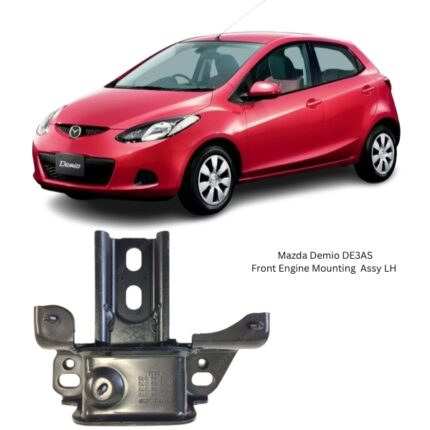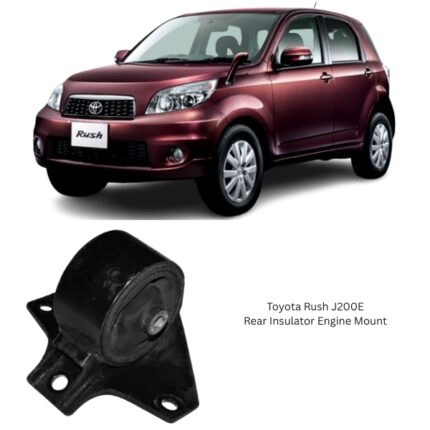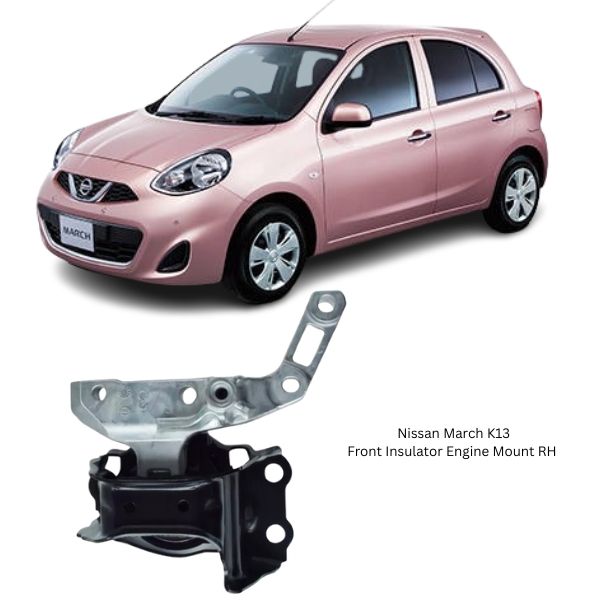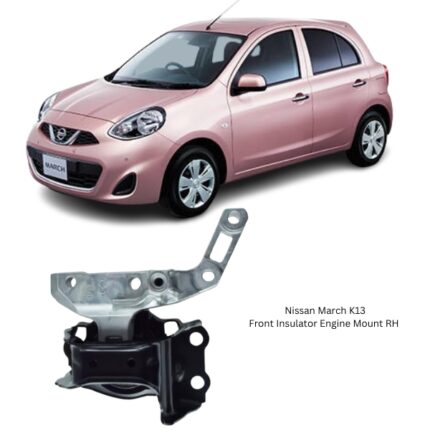Get Nissan March K13 Front Insulator Engine Mount RH 11210-1HC0C in Kenya
The Front Insulator Engine Mount RH (Right-Hand Side) is a critical component in a vehicle’s powertrain mounting system. Positioned on the right-hand side of the engine bay (from the driver’s perspective), this mount serves to secure the engine to the chassis, while also insulating and absorbing vibrations, reducing engine movement, and preserving alignment.
Made with high-performance materials and vibration-damping technology, the Front Insulator Engine Mount RH is engineered to endure harsh engine conditions—extreme heat, torque, and road shocks—while contributing to driving comfort and mechanical stability. It plays a significant role in managing NVH (Noise, Vibration, and Harshness) levels, protecting surrounding components, and maintaining the structural integrity of the engine bay.
Purpose and Functionality
The primary function of the Front Insulator Engine Mount RH is to support the weight of the engine and dampen the dynamic forces produced during operation. As the engine runs, it creates rotational torque and vibrational energy. Without proper isolation, this energy would transmit to the chassis and cabin, creating discomfort, noise, and mechanical stress.
Key responsibilities of the right-hand engine insulator mount include:
-
Load Bearing: Supports part of the engine’s weight, especially the side subjected to torque reaction forces.
-
Vibration Isolation: Absorbs and minimizes engine-induced vibrations for smoother cabin experience.
-
Engine Stability: Prevents excessive rocking or swaying during acceleration, braking, and shifting.
-
Torque Control: Manages rotational forces, especially from high-output engines, preserving drivetrain alignment.
-
Component Protection: Shields critical components (exhaust manifold, sensors, belts) from misalignment due to excessive engine movement.
Construction and Design
The Front Insulator Engine Mount RH is composed of precision-engineered parts built for strength, flexibility, and resistance to wear. It may be of a conventional rubber-metal type, hydraulic, or active electronic mount, depending on design and vehicle application.
Core Elements:
-
Mounting Bracket/Base Plate
Constructed from forged steel or cast aluminum, this provides the structural support for engine and chassis attachment. -
Elastomeric Isolator (Rubber or Polyurethane)
The insulator is the core vibration-damping element. It is bonded between metal plates and engineered with a specific durometer (hardness) to absorb vibrations while providing enough strength for load-bearing. -
Inner Sleeve/Core
A cylindrical metal or reinforced composite section that allows secure bolting and distributes force across the mount. -
Hydraulic Fluid Chamber (in fluid-filled mounts)
Some RH mounts use an internal oil chamber to actively dampen vibrations—especially low-frequency pulses at idle or under load. -
Electronic Actuator (in active mounts)
Advanced engine mounts can feature electronically controlled valves or actuators to vary damping based on driving conditions. -
Heat Shields (optional)
In mounts positioned close to hot engine components, a metal heat shield may be included to protect the insulator material from thermal degradation.
Performance Characteristics
The effectiveness of the Front RH Engine Mount depends on its ability to:
-
Isolate vibrations across various RPM ranges.
-
Support engine mass under static and dynamic conditions.
-
Withstand heat, oil exposure, and other under-hood contaminants.
-
Resist mechanical fatigue from torsional forces and continuous motion.
Properly functioning mounts ensure smooth engine operation and minimize noise transmission. Right-hand mounts, in particular, are typically under more torque stress due to the engine’s rotational direction.
Common Symptoms of a Worn or Failed Engine Mount
Over time, engine mounts are subject to fatigue, thermal breakdown, and wear. When the Front RH Engine Mount begins to fail, it may exhibit one or more of the following signs:
-
Excessive Vibration
Increased vibration in the cabin or steering wheel, especially at idle or low speeds. -
Engine Movement
Visible rocking or shifting of the engine during acceleration, deceleration, or when turning the engine on/off. -
Clunking or Thudding Noises
Noise when shifting gears or hitting bumps, caused by metal-on-metal contact from a collapsed mount. -
Misalignment of Engine Components
Pulling or stretching of belts, hoses, or electrical connectors due to engine mispositioning. -
Cracked or Deformed Rubber
Visual cracks, tears, or leaking hydraulic fluid (if the mount is fluid-filled).
Early diagnosis and replacement of a failing RH engine mount prevent damage to other systems and preserve vehicle safety.
Installation Guidelines
Installing a new Front RH Engine Mount requires mechanical knowledge and attention to detail. Improper installation can lead to premature wear or alignment issues.
General Steps:
-
Safety First
Ensure the vehicle is parked on a flat surface, and disconnect the battery. -
Support the Engine
Use an engine support bar or jack with a wood block to relieve weight from the mount. -
Remove Components for Access
In some cases, intake tubes, hoses, or battery trays may need to be moved. -
Unbolt the Old Mount
Remove the mounting bolts connecting the mount to both the engine and the chassis. -
Install the New Mount
Position the new RH mount, insert bolts, and torque them to the manufacturer’s specifications. -
Check Alignment
Ensure the engine sits level and all fasteners are secure. -
Reinstall Any Removed Parts
Put back any components that were temporarily removed for access. -
Test Run
Start the engine, observe for excessive movement or noise, and conduct a short test drive.
Maintenance and Inspection
While engine mounts do not require regular servicing, they should be inspected periodically, especially during:
-
Oil change services
-
Major engine or transmission work
-
Diagnosis of vibration or noise issues
-
Pre-purchase inspections
Look for:
-
Visible damage or cracks in the rubber insulator
-
Leaks (for hydraulic mounts)
-
Loose mounting hardware
-
Engine misalignment or tilt
Timely replacement ensures performance, comfort, and protection of the powertrain system.
Benefits of Replacing a Worn Front RH Mount
-
Reduced Cabin Noise and Vibration
Restores quiet and smooth engine operation. -
Enhanced Driving Comfort
Improves ride quality during acceleration, braking, and cruising. -
Protects Other Engine Components
Maintains proper alignment of belts, hoses, and mounts. -
Improved Transmission Shifts
Prevents excessive drivetrain movement that affects shifting. -
Prolongs Life of Adjacent Mounts
A new mount distributes engine load properly, avoiding over-stress on remaining mounts.
Follow us on Facebook for more parts.





Reviews
Clear filtersThere are no reviews yet.